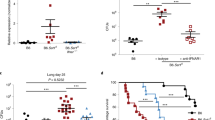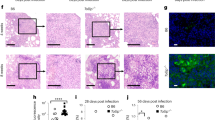Abstract
I/St and A/Sn mice are polar extremes in terms of several parameters defining sensitivity to Mycobacterium tuberculosis. TNF-α, mainly produced by activated macrophages, can mediate both physiological and pathophysiological processes. Adequate TNF-α levels are essential for a forceful protective response to M. tuberculosis. We have functionally characterized a nonsynonymous substitution, Arg8His, in the highly conserved cytoplasmic domain of the pro-TNF-α leader peptide from extremely M. tuberculosis-sensitive I/St mice. This was compared to the common pro-TNF-α variant found in A/Sn mice. Using cDNA constructs, both variants were constitutively expressed in HEK293A cells. A significantly higher secretion level of Arg8His TNF-α was shown using flow cytometry and ELISA analysis (P=0.0063), while intracellular levels were similar for both protein variants. An even TNF-α distribution throughout the cells was seen using confocal microscopy. This suggests that the Arg8His substitution affects pro-TNF-α processing. The I/St mouse may serve as a model to further explore the function of the well-conserved cytoplasmic region of TNF-α. However, other identified substitutions in the I/St promoter, introns and 3′UTR of Tnf-α, as well as the cellular environment in vivo may affect the balance between soluble and intracellular Arg8His TNF-α before and during M. tuberculosis infection.
This is a preview of subscription content, access via your institution
Access options
Subscribe to this journal
Receive 6 digital issues and online access to articles
$119.00 per year
only $19.83 per issue
Buy this article
- Purchase on Springer Link
- Instant access to full article PDF
Prices may be subject to local taxes which are calculated during checkout


Similar content being viewed by others
Accession codes
References
Nikonenko BV, Apt AS, Moroz AM, Averbakh MM . Genetic analysis of susceptibility of mice to H37Rv tuberculosis infection: sensitivity versus relative resistance. Prog Leuk Biol 1985; 3: 291–298.
Lavebratt C, Apt AS, Nikonenko BV, Schalling M, Schurr E . Severity of tuberculosis in mice is linked to distal chromosome 3 and proximal chromosome 9. J Infect Dis 1999; 180: 150–155.
Nikonenko BV, Apt AS, Moroz AM, Averbakh MM . Comparative analysis of mycobacterial infections in susceptible I/St and resistant A/Sn mice. Tuberc Lung Dis 2000; 80: 15–25.
Sanchez F, Radaeva TV, Nikonenko BV et al. Multigenic control of disease severity after virulent Mycobacterium tuberculosis infection in mice. Infect Immun 2003; 71: 126–131.
Dinarello CA . Proinflammatory cytokines. Chest 2000; 118: 503–508.
Vassalli P . The pathophysiology of tumor necrosis factors. Annu Rev lmmunol 1992; 10: 411–452.
Sharma R, Anker SD . Cytokines, apoptosis and cachexia: the potential for TNF antagonism. Int J Cardiol 2002; 85: 161–171.
Ware CF, VanArsdale S, VanArsdale TL . Apoptosis mediated by the TNF-related cytokine and receptor families. J Cell Biochem 1996; 60: 47–55.
Dinarello CA . Proinflammatory and anti-inflammatory cytokines as mediators in the pathogenesis of septic shock. Chest 1997; 112 (Suppl): 321S–329S.
Flynn JL . Immunology of tuberculosis and implications in vaccine development. Tuberculosis 2004; 84: 93–101.
Flynn JL, Goldstein MM, Chan J et al. Tumor necrosis factor-alpha is required in the protective immune response against Mycobacterium tuberculosis in mice. Immunity 1995; 2: 561–572.
Bean AG, Roach DR, Briscoe H et al. Structural deficiencies in granuloma formation in TNF gene-targeted mice underlie the heightened susceptibility to aerosol Mycobacterium tuberculosis infection, which is not compensated for by lymphotoxin. J Immunol 1999; 162: 3504–3511.
Roach DR, Bean AG, Demangel C, France MP, Briscoe H, Britton WJ . TNF regulates chemokine induction essential for cell recruitment, granuloma formation, and clearance of mycobacterial infection. J Immunol 2002; 168: 4620–4627.
Keane J, Gershon S, Wise RP et al. Tuberculosis associated with infliximab, a tumor necrosis factor alpha-neutralizing agent. N Engl J Med 2001; 345: 1098–1104.
Knight J . Polymorphisms in tumor necrosis factor and other cytokines as risks for infectious diseases and the septic syndrome. Curr Infect Dis Rep 2001; 3: 427–439.
Hajeer AH, Hutchinson IV . Influence of TNFalpha gene polymorphisms on TNFalpha production and disease. Hum Immunol 2001; 62: 1191–1199.
Tang P, Hung MC, Klostergaard J . Human pro-tumor necrosis factor is a homotrimer. Biochemistry 1996; 35: 8216–8225.
Kriegler M, Perez C, DeFay K, Albert I, Lu SD . A novel form of TNF/Cachectin is a cell surface cytotoxic transmembrane protein: ramifications for the complex physiology of TNF. Cell 1988; 53: 45–53.
Black RA, Rauch CT, Kozlosky CJ et al. A metalloproteinase disintegrin that releases tumour-necrosis factor-alpha from cells. Nature 1997; 385: 729–733.
Moss ML, Jin SL, Milla ME et al. Cloning of a disintegrin metalloproteinase that processes precursor tumour-necrosis factor-alpha. Nature 1997; 385: 733–736.
Perez C, Albert I, DeFay K et al. A nonsecretable cell surface mutant of tumor necrosis factor (TNF) kills by cell-to-cell contact. Cell 1990; 63: 251–258.
Decoster E, Vanhaesebroeck B, Vandenabeele P et al. Generation and biological characterization of membrane-bound, uncleavable murine tumor necrosis factor. J Biol Chem 1995; 270: 18473–18478.
Grell M, Douni E, Wajant H et al. The transmembrane form of tumor necrosis factor is the prime activating ligand of the 80 kDa tumor necrosis factor receptor. Cell 1995; 83: 793–802.
Utsumi T, Takeshige T, Tanaka K et al. Transmembrane TNF (pro-TNF) is palmitoylated. FEBS Lett 2001; 500: 1–6.
Ruuls SR, Hoek RM, Ngo VN et al. Membrane-bound TNF supports secondary lymphoid organ structure but is subservient to secreted TNF in driving autoimmune inflammation. Immunity 2001; 15: 533–543.
Majorov KB, Lyadova IV, Kondratieva TK et al. Different innate ability of I/St and A/Sn mice to combat virulent Mycobacterium tuberculosis: phenotypes expressed in lung and extrapulmonary macrophages. Infect Immun 2003; 71: 697–707.
Eruslanov EB, Majorov KB, Orlova MO et al. Lung cell responses to M. tuberculosis in genetically susceptible and resistant mice following intratracheal challenge. Clin Exp Immunol 2004; 135: 19–28.
Bastos KR, Marinho CR, Barboza R, Russo M, Alvarez JM, D’Imperio Lima MR . What kind of message does IL-12/IL-23 bring to macrophages and dendritic cells? Microbes Infect 2004; 6: 630–636.
Xing Z, Zganiacz A, Santosuosso M . Role of IL-12 in macrophage activation during intracellular infection: IL-12 and mycobacteria synergistically release TNF-alpha and nitric oxide from macrophages via IFN-gamma induction. J Leukocyte Biol 2000; 68: 897–902.
Bekker LG, Moreira AL, Bergtold A, Freeman S, Ryffel B, Kaplan G . Immunopathologic effects of tumor necrosis factor alpha in murine mycobacterial infection are dose dependent. Infect Immun 2000; 68: 6954–6961.
Alexopoulou L, Pasparakis M, Kollias G . A murine transmembrane tumor necrosis factor (TNF) transgene induces arthritis by cooperative p55/p75 TNF receptor signaling. Eur J Immunol 1997; 27: 2588–2592.
Tracey KJ, Fong Y, Hesse DG et al. Anti-cachectin/TNF monoclonal antibodies prevent septic shock during lethal bacteraemia. Nature 1987; 330: 662–664.
Mohler KM, Sleath PR, Fitzner JN et al. Protection against a lethal dose of endotoxin by an inhibitor of tumour necrosis factor processing. Nature 1994; 370: 218–220.
Mueller C, Corazza N, Trachsel-Loseth S et al. Noncleavable transmembrane mouse tumor necrosis factor-alpha (TNFalpha) mediates effects distinct from those of wild-type TNFalpha in vitro and in vivo. J Biol Chem 1999; 274: 38112–38118.
Zheng Y, Saftig P, Hartmann D, Blobel C . Evaluation of the contribution of different ADAMs to tumor necrosis factor α (TNFα) shedding and of the function of the TNFα ectodomain in ensuring selective stimulated shedding by the TNFα convertase (TACE/ADAM17). J Biol Chem 2004; 279: 42898–42906.
Gearing AJ, Beckett P, Christodoulou M et al. Processing of tumour necrosis factor-alpha precursor by metalloproteinases. Nature 1994; 370: 555–557.
Solomon KA, Covington MB, DeCicco CP, Newton RC . The fate of pro-TNF-alpha following inhibition of metalloprotease-dependent processing to soluble TNF-alpha in human monocytes. J Immunol 1997; 159: 4524–4531.
Glaser KB, Falduto M, Metzger R et al. Expression, release, and regulation of human TNF from stable transfectants of HEK-293 cells. Inflamm Res 1997; 46 (Suppl. 2): S127.
Solomon KA, Pesti N, Wu G, Newton RC . Cutting edge: a dominant negative form of TNF-α converting enzyme inhibits proTNF and TNFRII secretion. J Immunol 1999; 163: 4105–4108.
Reddy P, Slack JL, Davis R et al. Functional analysis of the domain structure of tumor necrosis factor-α converting enzyme. J Biol Chem 2000; 275: 14608–14614.
Itai T, Tanaka M, Nagata S . Processing of tumor necrosis factor by the membrane-bound TNF-α-converting enzyme, but not its truncated soluble form. Eur J Biochem 2001; 268: 2074–2082.
Utsumi T, Akimaru K, Kawabata Z et al. Human pro-tumor necrosis factor: molecular determinants of membrane translocation, sorting, and maturation. Mol Cell Biol 1995; 15: 6398–6405.
Cseh K, Beutler B . Alternative cleavage of the cachectin/tumor necrosis factor propeptide results in a larger, inactive form of secreted protein. J Biol Chem 1989; 264: 16256–16260.
Utsumi T, Levitan A, Hung MC, Klostergaard J . Effects of truncation of human pro-tumor necrosis factor transmembrane domain on cellular targeting. J Biol Chem 1993; 268: 9511–9516.
Han J, Brown T, Beutler B . Endotoxin-responsive sequences control cachectin/tumor necrosis factor biosynthesis at the translational level. J Exp Med 1990; 171: 465–475.
Han J, Beutler B . The essential role of the UA-rich sequence in endotoxin-induced cachectin/TNF synthesis. Eur Cytokine Netw 1990; 1: 71–75.
Beutler B . Regulation of cachectin biosynthesis occurs at multiple levels. Prog Clin Biol Res 1990; 349: 229–240.
Hel Z, Skamene E, Radzioch D . Two distinct regions in the 3′ untranslated region of tumor necrosis factor alpha mRNA form complexes with macrophage proteins. Mol Cell Biol 1996; 16: 5579–5590.
Caput D, Beutler B, Hartog K, Thayer R, Brown-Shimer S, Cerami A . Identification of a common nucleotide sequence in the 3′-untranslated region of mRNA molecules specifying inflammatory mediators. Biochemistry 1986; 83: 1670–1674.
Han J, Huez G, Beutler B . Interactive effects of the tumor necrosis factor promoter and 3′-untranslated regions. J Immunol 1991; 146: 1843–1848.
Schug J, Overton GC . Technical Report CBIL-TR-1997-1001-v0.0. Computational Biology and Informatics Laboratory School of Medicine, University of Pennsylvania, Pennsylvania, 1997.
Acknowledgements
This study was supported by grants from Swedish Medical Research Council, Karolinska Institutet Foundation, Magnus Bergwall Foundation, and Swedish Heart and Lung Foundation. We thank Ricardo Giscombe for skilful assistance with the flow cytometry experiments.
Author information
Authors and Affiliations
Corresponding author
Rights and permissions
About this article
Cite this article
Kähler, A., Persson, AS., Sánchez, F. et al. A new coding mutation in the Tnf-α leader sequence in tuberculosis-sensitive I/St mice causes higher secretion levels of soluble TNF-α. Genes Immun 6, 620–627 (2005). https://doi.org/10.1038/sj.gene.6364249
Received:
Revised:
Accepted:
Published:
Issue Date:
DOI: https://doi.org/10.1038/sj.gene.6364249
Keywords
This article is cited by
-
Mouse models of human TB pathology: roles in the analysis of necrosis and the development of host-directed therapies
Seminars in Immunopathology (2016)
-
Complex genetic control of susceptibility to Mycobacterium bovis (Bacille Calmette-Guérin) infection in wild-derived Mus spretus mice
Genes & Immunity (2006)
-
Genetic architecture of tuberculosis resistance in a mouse model of infection
Genes & Immunity (2006)



